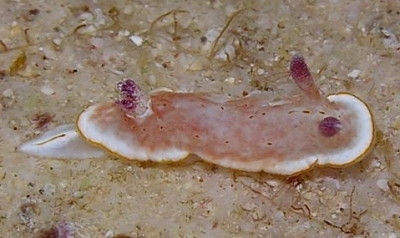
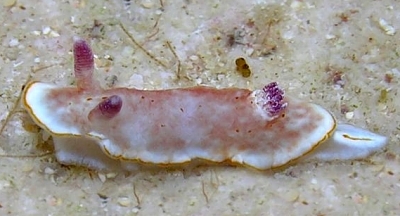
Chromodoris grahami
Thompson, 1980
Order: NUDIBRANCHIA
Suborder: DORIDINA
Superfamily: EUDORIDOIDEA
Family: Chromodorididae
DISTRIBUTION
Quite widely spread in the Caribbean
PHOTO
Locality: St Ann's Bay, 20 feet, Jamaica, West Indies, Caribbean Sea, May 28, 2006. Length: 4-5 mm. Photographer: Anne DuPont.
Background colour of the mantle a mottled translucent salmon pink to red with small bright red or orange spots arranged in three longitudinal lines, one down the midline, and another behind each of the rhinophores. Each spot is surrounded by a clear whitish ring. There is a broad white band around the mantle margin, and overlying it, just in from the edge, is a thin yellow-orange line. The foot is translucent white with a broad white border and a white line down the posterior midline. There can be a yellow orange line in the middle of the medio-dorsal white line on the posterior foot. The rhinophore stalks are transparent with a reddish purple club, sometimes speckled with white and with a translucent white tip. The gills are translucent pinkish with the upper half a reddish-purple. There is a white edge, with scattered orange -red spots, around the gill pocket. It grows to aproximately 20 mm in length
-
Thompson, T.E. (1980) Jamaican Opisthobranch Molluscs II. Journal of Molluscan Studies, 46: 74-99
Rudman, W.B., 2007 (October 15) Chromodoris grahami Thompson, 1980. [In] Sea Slug Forum. Australian Museum, Sydney. Available from http://www.seaslugforum.net/find/chrograh
Related messages
Chromodoris grahami from Jamaica
October 16, 2007
From: Anne DuPont
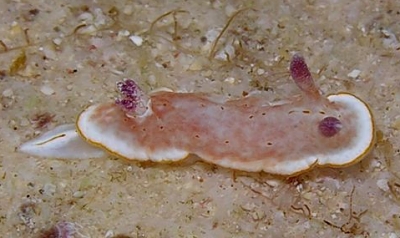
Concerning message #20942:
Hello Bill,
On the subject of the Caribbean group of species with orange or pink markings on the mantle and a yellow border, I noticed that on the fact sheet for Chromodoris grahami, you asked for photos. I am sending you two photos (same animal) which appear to be a juvenile specimen of C. grahami. Hope this helps.
Locality: St Ann's Bay, 20 feet, Jamaica, West Indies, Caribbean Sea, May 28, 2006. Length: 4-5 mm. Photographer: Anne DuPont.
Thanks again for the wonderful forum.
Cordially,
Anne DuPont
Delray Beach, Fl., USA
akdupont@bellsouth.net
DuPont, A., 2007 (Oct 16) Chromodoris grahami from Jamaica. [Message in] Sea Slug Forum. Australian Museum, Sydney. Available from http://www.seaslugforum.net/find/20957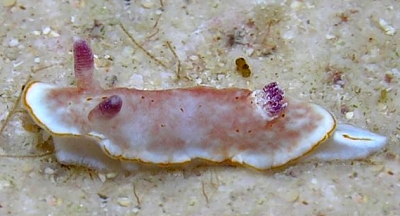
Dear Anne,
Thanks very much for these photos. They fit Tom Thompson's original description of the species almost exactly which is somewhat of a surprise since Caribbean species suually cause some headaches when we try and identify them. Even though your animal is quite small, it seems to have its adult form and colour. This will give me a chance to prepare a proper Fact Sheet for the species.
Best wishes,
Bill Rudman
Pink Chromodoris grahami from Colombia
September 22, 2001
From: Elianny Dominguez
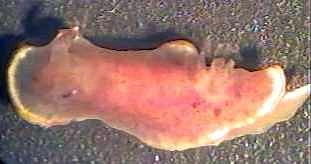
Dear Bill,
I'm sending you the photos of the pink form of Chromodoris grahami. We found both animals in May but I went back to the same place on June and I saw two more of them (white and pink) right on the same spot. There are some sewage waters from the houses constructed there, and it seems to us that all the animals of Chromodoris and Pleurobranchus that we have found since March of 2001, were always near the sewage waters.
I read on the Forum that you don't think Aplysians care so much for sewage waters; do you think the same way about the animals on this place.
Kind regards,
Elianny Dominguez.
elicelotte@latinmail.com
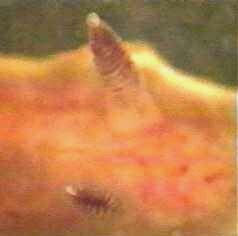
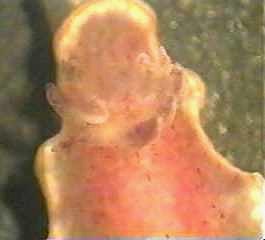
Thanks Elianny,
I don't remember saying Aplysiids don't like sewage - perhaps it was the discussion suggesting that large populations of Bursatella leachi indicated sewerage pollution. I don't really want ot get into a discussion on the subject because it is very complicated. Sewerage itself can cause problems of eutrophication, excess of nutrients leading to excess plant and bacterial growth and deoxygenation. But often with house waste it is the other chemical wastes - detergents, poisons etc which are the problem.
I must say that the leaking main sewer pipe in Dar es Salaam, Tanzania, which ran across an intertidal raised reef when I lived there, was a very good place to find nudibranchs, presumably because the added nutrients allowed a lush growth of sponges, hydroids and other colonial animals that nudibranchs like to eat, but I wouldn't consider that a good reason not to fight pollution wherever possible.
Cheers,
Bill Rudman
Chromodoris grahami? from Colombia
September 15, 2001
From: Elianny Dominguez Tejo
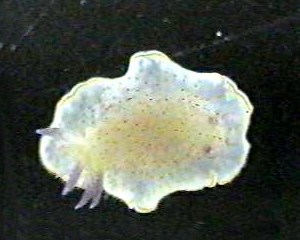
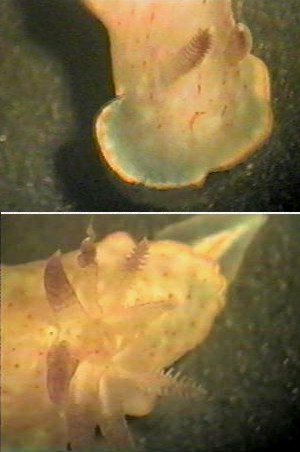
Dear Bill,
I'm sending you some close up pictures of the nudibranch you thought might be Chromodoris grahami. This is the one that is mostly white; the other one is identical but has a dark pink background colour. You can see that the rinophores are dark purple and they have a few rings. We found it under a rock, at about 10cm of depth at the Caribbean coast of Colombia.
Would you like some better pictures of the pink one as well?
Cheers,
Elianny Dominguez
elicelotte@latinmail.com
Dominguez Tejo , 2001 (Sep 15) Chromodoris grahami? from Colombia. [Message in] Sea Slug Forum. Australian Museum, Sydney. Available from http://www.seaslugforum.net/find/5267Dear Elianny,
Yes this is Chromodoris grahami. Some better photos of the pink one would be useful.
Thanks,
Bill Rudman
Chromodoris grahami? from Colombia
June 2, 2001
From: Elianny Domínguez
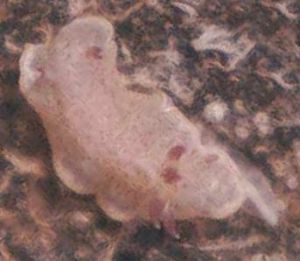
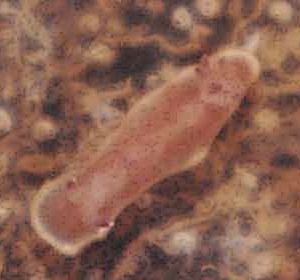
Dear Bill,
We found this two nudibranchs on a rocky shore, in Gaira Bay, Santa Marta, Caribbean coast of Colombia, intertidally. The pink one was 1.5 cm of length and the white one was 2 cm.
On the edge of the body there is a bright yellow line. The white one has little pink-red dots on the dorsal. And they both have purple rhinophores.
Someone told me they might be Chromodoris neona. Can you help me out?
Cheers,
Elianny.
elicelotte@latinmail.com
Domínguez, E., 2001 (Jun 2) Chromodoris grahami? from Colombia. [Message in] Sea Slug Forum. Australian Museum, Sydney. Available from http://www.seaslugforum.net/find/4425Dear Elianny,
Your photos aren't very clear and my knowledge of the Caribbean fauna is based entirely on publications so I may be wrong, but I think these photos are of Chromodoris grahami a species originally described from Jamaica (Thompson, 1980).
Best wishes,
Bill Rudman
